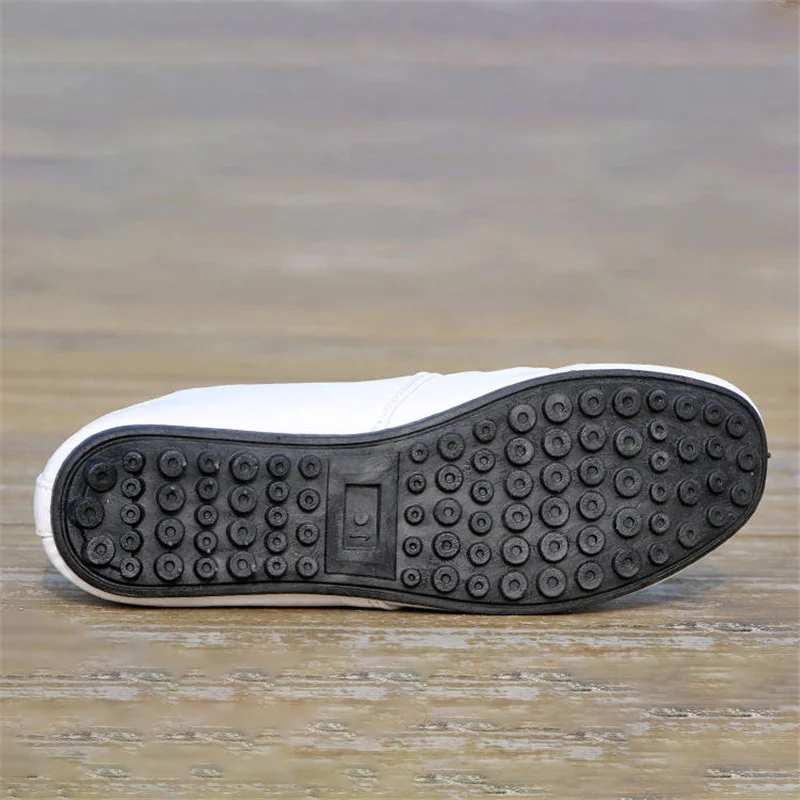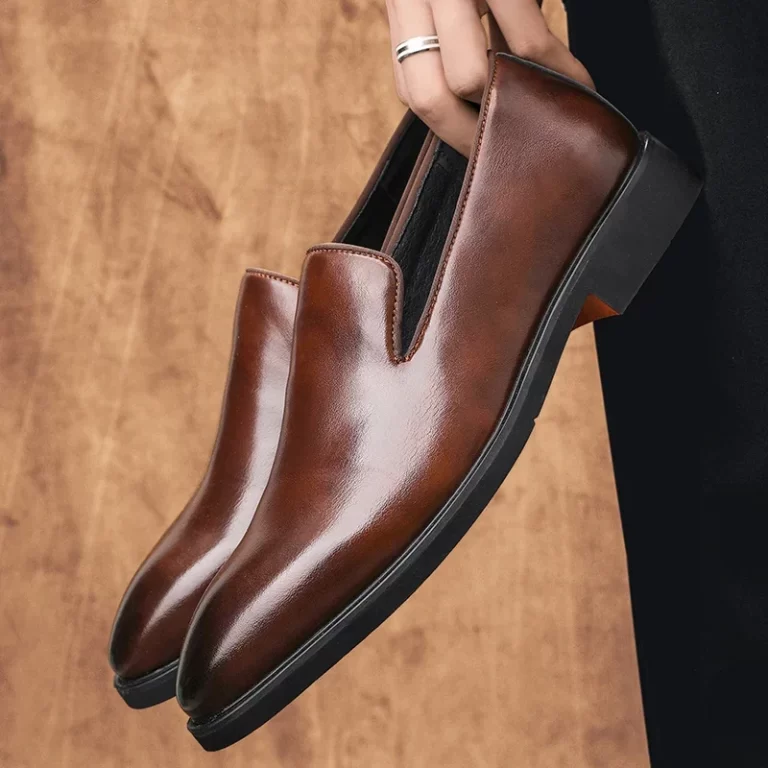Introduction
Leather shoes are a staple in many wardrobes, known for their elegance and durability. However, when it comes to weather, many people wonder: are leather shoes waterproof? The answer is not simple. Leather has natural properties, but it doesn’t always mean it can handle water well. Let’s delve deeper into the characteristics of leather, how waterproofing works, and the best ways to care for leather shoes.

Understanding Leather: The Basics
What is Leather?
Leather is a material made from animal hides, primarily cowhide. It undergoes a tanning process to turn it into a durable fabric suitable for manufacturing various goods, including shoes. Leather comes in many different types, such as full-grain, top-grain, genuine leather, and bonded leather. Each type has unique characteristics that affect its durability, appearance, and ability to resist water.
How Leather Handles Water
Natural leather has some resistance to water. The fibers in leather are tightly woven, which can keep water out to a certain extent. However, when leather gets soaked, it absorbs moisture, leading to potential damage over time. Prolonged exposure can cause leather to become stiff, lose its shape, or develop mold and mildew. Therefore, while leather can handle light rain or splashes, it is not completely waterproof.
The Myths of Waterproof Leather
Common Misconceptions
Many people believe that all leather shoes are waterproof. This misconception can lead to problems when wearing leather shoes in wet conditions. Not all leather is created equal. Some types are more water-resistant than others. For instance, full-grain leather, which uses the outer layer of the hide, offers better resistance due to its thickness and natural oils.
On the other hand, genuine leather can be treated with a protective coating, making it more resistant to water. However, this doesn’t mean it is waterproof. Instead, it can repel water for short periods. Educating yourself on leather varieties will help you choose the right kind for your needs.
Waterproofing Treatments
There is a wide array of waterproofing treatments available for leather shoes. Some treatments can enhance the water resistance of high-quality leather. These products form a barrier on the surface, preventing moisture from penetrating the material. However, they are not invincible. Over time, the effectiveness of these coatings can diminish. Regular reapplication may be necessary for prolonged protection.

Proper Care for Leather Shoes
Cleaning Your Leather Shoes
Cleaning is a vital part of leather shoe maintenance. Dirt and grime can accumulate on the surface, which can damage the leather. Start by removing any loose dirt using a soft brush. Follow this with a damp cloth to wipe down the shoe. Avoid soaking the leather, as too much water is counterproductive. Once cleaned, allow the shoes to dry naturally. Never use heat sources like a hairdryer, as this can crack the leather.
Conditioning Your Leather Shoes
Conditioning helps maintain the leather’s natural oils and suppleness. Dry leather can become brittle and crack, especially with exposure to moisture. Apply a quality leather conditioner using a soft cloth. Ensure that you cover all areas, including seams. This process is particularly important after cleaning. Conditioning should be done every few months, or more often if you frequently expose your shoes to water.
Enhancing Waterproofing: Options and Choices
Selecting the Right Products
If you want waterproof leather shoes, consider investing in high-quality options. Look for brands that specifically market their shoes as waterproof. These shoes often undergo rigorous testing to ensure they withstand wet conditions. If you have shoes already, explore waterproof sprays and creams designed for leather. These products can help enhance water resistance while maintaining the leather’s breathability.
DIY Solutions for Waterproofing
Some people prefer a DIY approach to waterproofing. One popular method involves beeswax. Applying beeswax to leather shoes creates a natural water-resistant barrier. Melt the beeswax, and use a cloth to rub it into the leather. After application, use a heat source, like a hairdryer, on a low setting to help the wax penetrate the material. However, this method may change the appearance of the leather, giving it a slightly darker tint.
Key Considerations for Different Conditions
Choosing the Right Shoes for the Weather
When choosing leather shoes, consider the weather conditions you often encounter. For wet environments, look for shoes specifically designed to handle these conditions. Some brands offer leather shoes with rubber soles. This combination enhances grip and water resistance. Avoid wearing regular leather shoes in heavy rain or snow, as they were not built for such conditions.
Seasonal Storage for Your Shoes
Proper storage can extend the life of your leather shoes. Store them in a cool, dry place away from direct sunlight. Extremes in temperature can harm the leather. Additionally, keep shoes in their original box or a dust bag to prevent dust buildup. Adding shoe trees can help maintain their shape and prevent creasing during storage.
Troubleshooting Water Damage
Identifying Damage Signs
If your leather shoes get wet, it’s essential to check for damage. Look for water stains, which often appear as darkened spots. If ignored, these spots can become permanent. Additionally, inspect the leather for cracks or stiffness, indicating prolonged water exposure. Catching these signs early allows you to take preventive measures.
Steps to Repair Water-Damaged Leather
If your shoes suffer water damage, don’t panic. Start by drying them out gently using paper towels. Place them in a well-ventilated area but away from direct heat. Once thoroughly dry, use a leather conditioner to restore some moisture. If stains persist, consider using a specialized leather cleaner. For significant damage, consulting a professional cobbler may be your best option.

How to Make Leather Shoes More Water-Resistant
Waterproofing Sprays and Creams
The most effective way to make leather shoes more water-resistant is by applying waterproofing sprays or creams. These products form a protective barrier on the leather’s surface, preventing water from soaking in. They are easy to apply and can be used on a variety of leather types. Look for products specifically designed for leather shoes, as they will provide the best results without damaging the material.
To apply waterproofing spray, hold the can about six inches away from the leather and spray a light, even coat over the surface. Be sure to cover the entire shoe, including the seams and stitching. After application, allow the shoes to dry completely before wearing them. Waterproofing creams are applied in a similar manner, but they may require more time to soak into the leather.
Leather Conditioner
Another important step in protecting leather shoes from water damage is conditioning the leather. Leather conditioner helps to maintain the natural oils in the material, preventing it from drying out and becoming brittle. Applying a conditioner regularly can also improve the leather’s water resistance. Choose a high-quality conditioner that is designed for leather shoes and apply it after cleaning the shoes to help preserve their appearance and extend their lifespan.
Sealing the Seams
In addition to treating the leather itself, it’s important to seal the seams of leather shoes. The stitching is often the most vulnerable part of the shoe when it comes to water exposure. You can use seam sealer products to coat the stitching and create a water-resistant barrier. This will help prevent moisture from seeping in through the seams and damaging the interior of the shoe.
Avoiding Wet Conditions
Even with the best waterproofing treatments, it’s still a good idea to avoid exposing leather shoes to wet conditions whenever possible. If you know you’ll be walking through heavy rain or snow, consider wearing waterproof boots instead. If your leather shoes do get wet, dry them properly and apply conditioner or a waterproofing treatment to help restore their water resistance.
Conclusion
In summary, leather shoes possess some water resistance but are not fully waterproof. They can handle light moisture and require proper care to maintain their look and longevity. Educate yourself on the types of leather and the appropriate treatments available. Investing in quality products, applying regular maintenance, and understanding your local weather conditions will help you keep your leather shoes in great shape. Whether you’re dashing through puddles or walking in wine country, staying informed and prepared ensures your shoes can endure a variety of conditions without sacrificing style.

